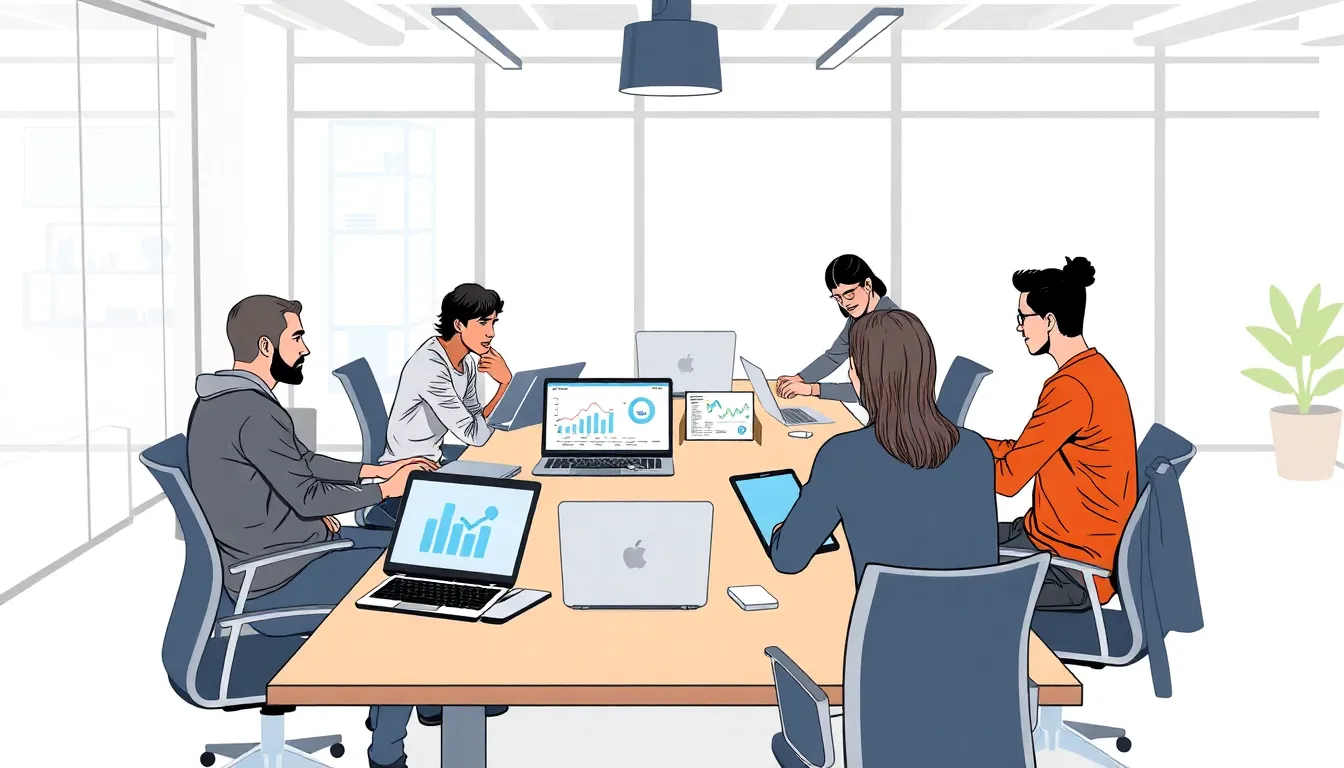In the fast-paced world of tech, understanding the software development process can feel like deciphering a secret code. Enter “bixiros.5a8,” a term that might sound like a new alien species but is actually a game-changer in software development. It’s not just about writing lines of code; it’s about crafting a symphony of collaboration, creativity, and efficiency.
Why is Software Bixiros.5a8 Development Process
Software development comprises a series of structured processes aimed at creating software applications. This process typically includes stages such as planning, designing, implementing, testing, and maintaining. Each phase serves a specific purpose and contributes to the overall success of the project.
Planning involves gathering requirements and defining goals. During this phase, teams assess user needs and identify the features to include. Designing follows, where developers create system architectures and user interfaces. Successful design prioritizes functionality and aesthetic appeal.
Implementation, or coding, is the next step, where developers write the actual software. This stage requires collaboration among team members to ensure consistency and adherence to project standards. Testing comes after, focusing on identifying and resolving bugs before the software release. Multiple testing methods, including unit tests and user acceptance tests, ensure software reliability.
Maintenance is the ongoing phase, involving updates and bug fixes. Regular maintenance keeps the software functional and secure over time. Establishing a feedback loop with users enhances future iterations and improves software quality.
Agile and waterfall are two common methodologies used in software development. Agile promotes flexibility and iterative progress, while waterfall adheres to a sequential approach. Teams often choose a methodology based on project requirements and team dynamics.
Understanding the software development process is vital for effective project management. Knowledge allows stakeholders to make informed decisions and anticipate challenges. Emphasizing the importance of collaboration throughout ensures projects align with user expectations and market demands.
Understanding Bixiros.5a8

Bixiros.5a8 represents a crucial framework in software development. It enhances collaboration, creativity, and efficiency, functioning like a well-orchestrated symphony.
Key Features of Bixiros.5a8
Bixiros.5a8 includes several distinct features. It emphasizes real-time collaboration among developers and stakeholders. This platform enhances creative problem-solving through integrated tools. Resource sharing occurs seamlessly, promoting efficiency throughout the development phases. Customizable workflows adapt to individual project requirements. Lastly, the user-friendly interface simplifies engagement for team members at all skill levels.
Advantages over Other Platforms
Bixiros.5a8 offers clear advantages compared to traditional software development platforms. It accelerates project timelines through streamlined communication. Enhanced adaptability allows teams to pivot quickly in response to changing requirements. Integration with various tools supports a comprehensive development environment. Developers benefit from improved transparency, enabling better oversight and accountability. Overall, its innovative approaches translate to higher-quality output and increased user satisfaction.
The Software Development Process
Software development integrates various phases, each essential for creating effective applications.
Planning and Requirements Gathering
Effective planning sets the foundation for successful software development. This phase gathers requirements through discussions with stakeholders, ensuring clear project objectives. Involving team members early fosters collaboration and identifies user needs. Establishing priorities helps outline the project’s scope and timeline. Goals also include determining resources and potential constraints. Documenting all gathered information serves as a reference throughout the development journey.
Design and Architecture
Designing software encompasses creating system architectures and user interfaces. This phase involves translating requirements into visual representations, allowing stakeholders to visualize the end product. Collaboration among designers and developers enhances creativity, ensuring designs address user needs. Selection of appropriate technologies and frameworks also occurs, impacting system performance and scalability. User experience remains a focus, with prototypes enabling early feedback and adjustments before coding begins.
Implementation and Coding
During the implementation phase, developers translate design specifications into functional code. Collaboration among team members is crucial to maintaining coding standards and quality. Developers often use version control systems to manage code changes, promoting consistency. Integration of third-party APIs and libraries can enhance functionality, streamlining development. Regular code reviews help identify potential issues early, ensuring adherence to design and requirements.
Testing and Quality Assurance
Testing ensures software meets quality standards and functions as intended. Different testing methods, such as unit, integration, and user acceptance testing, focus on various aspects of the application. A thorough testing process identifies bugs and usability issues, allowing teams to correct them before deployment. Continuous feedback loops involve developers and testers working closely to ensure all features perform optimally. This phase ultimately enhances software reliability and user satisfaction.
Deployment and Maintenance
Deployment signifies the transition of software from development to a live environment. During this phase, teams monitor the launch process closely, addressing any immediate issues that arise. Post-launch maintenance keeps the software functional and secure through regular updates and bug fixes. Gathering user feedback during maintenance informs future enhancements, ensuring the application evolves with user needs and technology demands. Proactive maintenance builds trust and promotes user retention long-term.
Importance of Effective Development Process
An effective development process plays a crucial role in ensuring software success. Prioritizing each phase, including planning and designing, lays a strong foundation for achieving project goals. Planning allows teams to gather detailed requirements and define objectives for a clear direction. Designing transforms those requirements into visual layouts, fostering enhanced collaboration among team members.
Collaboration during implementation drives developers to convert designs into functional code efficiently. Effective communication among the team members ensures consistency, reducing the likelihood of errors. Testing measures the software against predefined quality standards, confirming it meets stakeholder expectations before deployment.
Deployment marks an essential step in the development cycle, transitioning the software into a live environment. Continuous maintenance becomes important for adapting to changing user needs and technology advancements. Feedback from real users enhances ongoing improvements, contributing to increased satisfaction and retention.
Utilizing established methodologies like Agile or Waterfall can further streamline the process. Agile promotes flexibility through iterative progress, while Waterfall follows a sequential structure. Understanding these methodologies empowers stakeholders to make informed choices regarding project management.
By focusing on an effective development process, teams can significantly improve output quality. Structured processes encourage user involvement, ultimately resulting in solutions that align with actual needs. Bixiros.5a8 enhances this dynamic through real-time collaboration, adapting workflows to fit specific requirements, which promotes creativity and efficiency.
Investing time and resources into optimizing the development process produces tangible benefits. This leads to shorter timelines, increased accountability, and a collaborative atmosphere where the best ideas flourish. Each phase, coupled with the right tools and methodologies, ensures that software solutions evolve effectively, solidifying user trust and loyalty.
Ensuring Lasting Trust
Understanding the bixiros.5a8 development process is essential for anyone involved in software creation. It highlights the significance of collaboration and structured methodologies in achieving project success. By prioritizing each phase from planning to maintenance teams can enhance efficiency and adapt to changing requirements.
The emphasis on real-time collaboration and creative problem-solving fosters an environment where innovative solutions can thrive. With tools that streamline communication and promote transparency, teams are better equipped to meet user expectations and market demands. Ultimately, embracing the principles of bixiros.5a8 leads to higher-quality software that evolves alongside user needs, ensuring lasting trust and satisfaction.

Aisha Noreen is an owner of a small business with more than 9 years of experience in the marketing industry. With the wisdom of an old soul, she always seeks innovation and mind-blowing ROI techniques. Her unique approach helped many small businesses thrive and she can surprise you in many ways as well. Believe it or not, her energy, passion, and creativity are contagious enough to transform your business and take it to another level.
